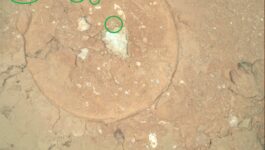
Are these green marks on Mars proof of life? We asked an astrobiologist
If bacteria helped reduce this oxidized iron on Mars, then it is nothing less than the greatest discovery in all of our history, with a capital “H”. Because if there was life on Mars, then we have two habitable planets that were inhabited in the same star system. Which would imply the near certainty that other lives exist elsewhere, which is still not a consensus.
The NASA Rover – and a little bit of the ESA! – searches for traces of life on Mars, of a probably past life. It is in a crater called Jezero which we know was filled with water 3 billion years ago.
On Earth, including in France, certain red rocks obtain this color due to oxidation of iron (Fe 3), the same one that colors our blood.
Show EXIF March ? No, Roussillon, the Colorado of Provence, in Vaucluse in France! © ouramericandream.fr
And precisely, on Earth, we can find this type of greenish spots in the “red beds” of oxidized rock when liquid water percolates through the sediments. A chemical reaction then occurs and the oxidized iron is transformed into its reduced species (Fe 2-). However, as we said above, bacteria can take part in this process – at least on our good old blue planet. SO ?
Did Martian bacteria help oxidize the rock in this NASA photo? We asked an astrobiologist from the CNRS for his opinion.
Nicolas Rividi (which can be followed on) is a research engineer at the CNRS, geochemist and astrobiologist. So we showed him the famous image and asked what he thought of it.
Nicolas Rividi: “The photo is not of great quality and other data is needed. Reduction of iron to Fe 2- is quite possible. Unfortunately, there is a good chance that this process is abiotic, therefore not biological at all.“.
“I would opt for circulations of hydrothermal reducing fluids in a lake bottom context. Discriminating the abiotic and biological process is also difficult: all biological signatures have an abiotic mechanism which creates the same signature! I just submitted a financing project to try to sort all this out…“
So, biological process? Non-organic?
We understand, on this image alone, it is too difficult to decide. These green spots should have been sampled directly with the Rover's arm, but there was not enough space and the risks of damaging Perseverance and its instruments were too great.
Regardless, we are moving forward in our knowledge of Mars, its exciting geology and its past history which contains part of the answers to the biggest question we ask ourselves: “Is there life somewhere, else?“





